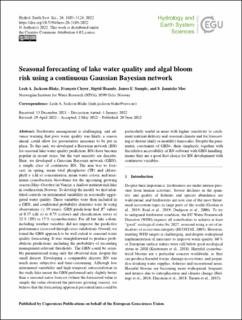| dc.description.abstract | Freshwater management is challenging, and advance warning that poor water quality was likely, a season ahead, could allow for preventative measures to be put in place. To this end, we developed a Bayesian network (BN) for seasonal lake water quality prediction. BNs have become popular in recent years, but the vast majority are discrete. Here, we developed a Gaussian Bayesian network (GBN), a simple class of continuous BN. The aim was to forecast, in spring, mean total phosphorus (TP) and chlorophyll a (chl a) concentration, mean water colour, and maximum cyanobacteria biovolume for the upcoming growing season (May–October) in Vansjø, a shallow nutrient-rich lake in southeastern Norway. To develop the model, we first identified controls on interannual variability in seasonally aggregated water quality. These variables were then included in a GBN, and conditional probability densities were fit using observations (≤39 years). GBN predictions had R2 values of 0.37 (chl a) to 0.75 (colour) and classification errors of 32 % (TP) to 17 % (cyanobacteria). For all but lake colour, including weather variables did not improve the predictive performance (assessed through cross-validation). Overall, we found the GBN approach to be well suited to seasonal water quality forecasting. It was straightforward to produce probabilistic predictions, including the probability of exceeding management-relevant thresholds. The GBN could be sensibly parameterised using only the observed data, despite the small dataset. Developing a comparable discrete BN was much more subjective and time-consuming. Although low interannual variability and high temporal autocorrelation in the study lake meant the GBN performed only slightly better than a seasonal naïve forecast (where the forecasted value is simply the value observed the previous growing season), we believe that the forecasting approach presented here could be particularly useful in areas with higher sensitivity to catchment nutrient delivery and seasonal climate and for forecasting at shorter (daily or monthly) timescales. Despite the parametric constraints of GBNs, their simplicity, together with the relative accessibility of BN software with GBN handling, means they are a good first choice for BN development with continuous variables. | en_US |

